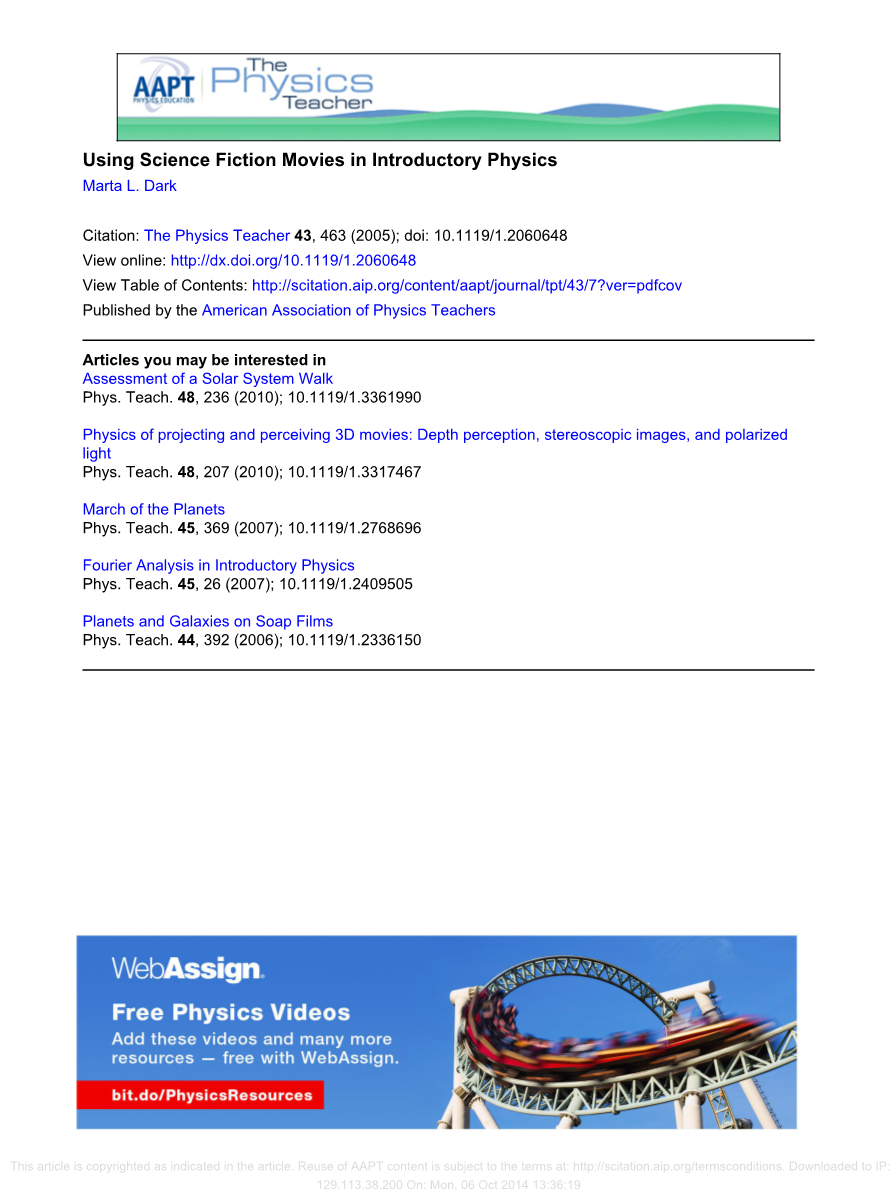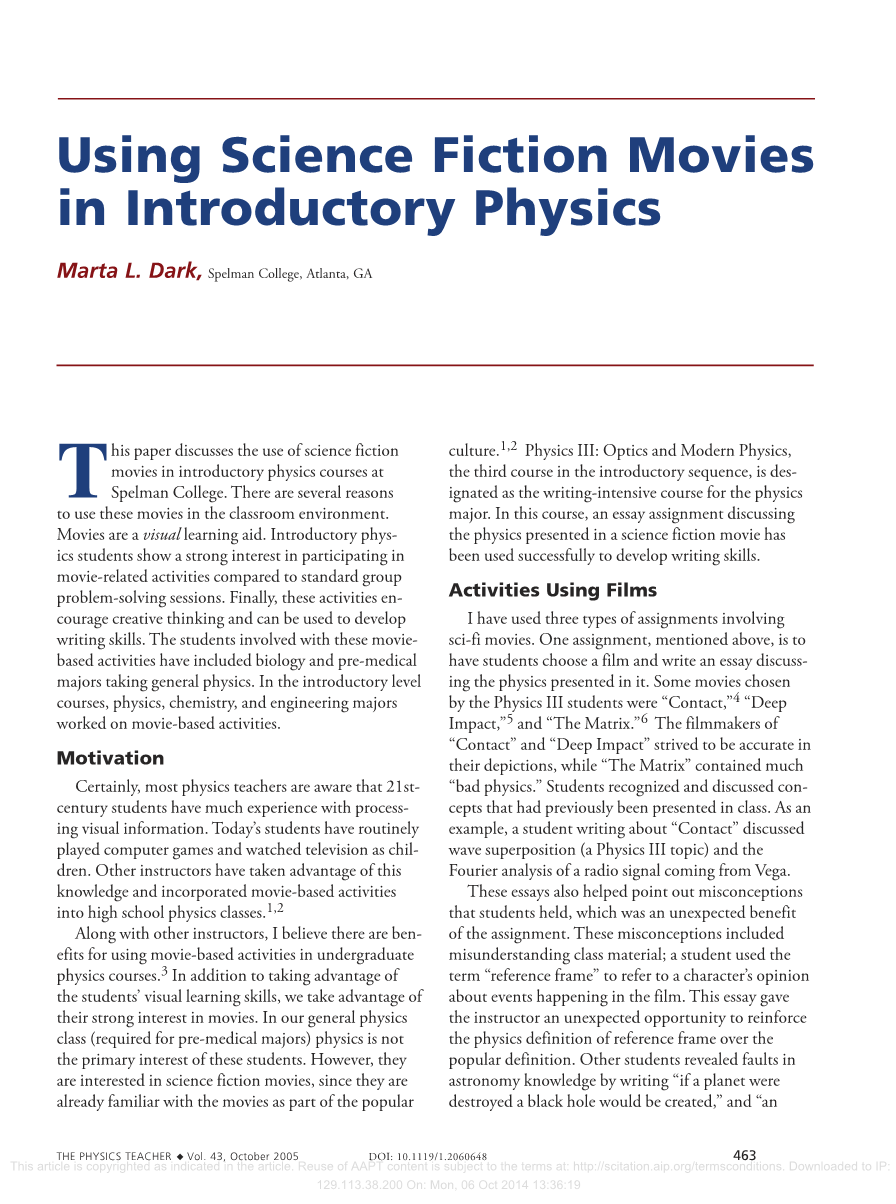Using Science Fiction Movies in Introductory Physics
Marta L. Dark,Spelman College,Atlanta,GA
This paper discusses the use of science fiction movies in introductory physics courses at Spelman College. There are several reasons to use these movies in the classroom environment. Movies are a visual learning aid. Introductory physics students show a strong interest in participating in movie-related activities compared to standard group problem-solving sessions. Finally, these activities encourage creative thinking and can be used to develop writing skills. The students involved with these moviebased activities have included biology and premedical majors taking general physics. In the introductory level courses, physics, chemistry, and engineering majors worked on movie-based activities.
Motivation
Certainly, most physics teachers are aware that 21stcentury students have much experience with processing visual information. Todayrsquo;s students have routinely played computer games and watched television as children. Other instructors have taken advantage of this knowledge and incorporated movie-based activities into high school physics classes.1,2 Along with other instructors, I believe there are benefits for using movie-based activities in undergraduate physics courses3 .In addition to taking advantage of the studentsrsquo; visual learning skills, we take advantage of their strong interest in movies. In our general physics class (required for pre-medical majors) physics is not the primary interest of these students. However, they are interested in science fiction movies, since they are already familiar with the movies as part of the popular culture.1,2 Physics III: Optics and Modern Physicsthe third course in the introductory sequence, is designated as the writing-intensive course for the physics major. In this course, an essay assignment discussing the physics presented in a science fiction movie has been used successfully to develop writing skills.
Activities Using Films
I have used three types of assignments involving sci-fi movies. One assignment, mentioned above, is to have students choose a film and write an essay discussing the physics presented in it. Some movies chosen by the Physics III students were “Contact,”4 “Deep Impact,”5 and “The Matrix.”6 The filmmakers of “Contact” and “Deep Impact” strived to be accurate in their depictions, while “The Matrix” contained much “bad physics.” Students recognized and discussed concepts that had previously been presented in class. As an example, a student writing about “Contact” discussed wave superposition (a Physics III topic) and the Fourier analysis of a radio signal coming from Vega. These essays also helped point out misconceptions that students held, which was an unexpected benefit of the assignment. These misconceptions included misunderstanding class material; a student used the term “reference frame” to refer to a characterrsquo;s opinion about events happening in the film. This essay gave the instructor an unexpected opportunity to reinforce the physics definition of reference frame over the popular definition. Other students revealed faults in astronomy knowledge by writing “if a planet were destroyed a black hole would be created,” and “an asteroid is formed from dying stars.” Because astronomy is not a course offering at Spelman College, such an error would have normally gone unnoticed during the studentrsquo;s college career. Therefore, the essay assignment proved to be valuable. In addition, two other types of assignments follow in-class showings of brief film excerpts. Students either 1) discuss examples of correct and incorrect physics as presented in the scene, or 2) make calculations using the filmrsquo;s “data” to determine whether or not the physical quantity involved is reasonable. An example of the second activity was developed from the movie “Armageddon”7 for the Physics I: Mechanics recitation.
Armageddon” Activity
For this 50-minute, group-work assignment, students are first given a brief background on the moviersquo;s plot: In the movie “Armageddon,” NASA realizes Earth has 18 days before it is destroyed by impact with an asteroid the size of Texas. Their solution is to land a team of oil drillers and astronauts on the asteroid, drop a nuclear warhead into its core, and split the asteroid into two pieces that will safely pass by the Earth. This must happen before “zero barrier,” four hours before impact. The class then watches two brief scenes from the film totaling approximately six minutes.7 It is then up to the students to determine if NASArsquo;s scheme will really work. The asteroid is said to be the “size of Texas,” and the class is told that Texas is approximately 900 miles (1.45 x 106 m) across. Students are given an approximate value for density of rock,rho;asymp; 3000 kg/m3; therefore, they can calculate the mass of the asteroid by approximating its geometry to be spherical.
Our class uses a textbook in which momentum is presented before energy.8 Students have not yet been introduced to energy when this activity is given; therefore, they are told to assume that all of the energy from the explosion is converted to kinetic energy. The class is also told how kinetic energy relates to the speed (the y-component of velocity v in Fig. 1) with which the asteroid halves move apart: vy = ) The total energy (4 x 1015 J for a typical one-megaton nuclear warhead) is divided equally between the two halves of the asteroid; thus, each half receives a kinetic energy of K = 2 x 1015 J. The mass of each half of the asteroid is m = 2.4 x 1021 kg, one-half of the total mass. Given this information and Eq. (1), students estimate the speed to be vyasymp;1 x 10-3 m/s.
The students must make several assumptions to determine if the asteroi
剩余内容已隐藏,支付完成后下载完整资料


英语原文共 4 页,剩余内容已隐藏,支付完成后下载完整资料
资料编号:[273134],资料为PDF文档或Word文档,PDF文档可免费转换为Word
您可能感兴趣的文章
- 酞菁钴诱导的二维黑色鳞光体铁磁性外文翻译资料
- 用于光学非线性测量的带相位物体的时间分辨泵浦探测技术外文翻译资料
- 专业知识和任务指导专一性是准教师专业视野的影响因素外文翻译资料
- 物理学中的探索太阳能热水器物理概念教学的建议外文翻译资料
- 与传统教学相比,翻转教学对工科学生在物理实验室表现的有效性的数据集外文翻译资料
- 什么是伟大的教学?(P8-P17)外文翻译资料
- 早期外语学习对初中至高中语言能力发展的影响外文翻译资料
- 单负和双正材料组合结构中电磁波隧穿现象的研究外文翻译资料
- 对美国宾夕法尼亚Marcellus气井回流盐水的地球化学评价外文翻译资料
- 中国的探究式学习:教师们是否真的实践了他们所宣扬的,为什么?外文翻译资料


